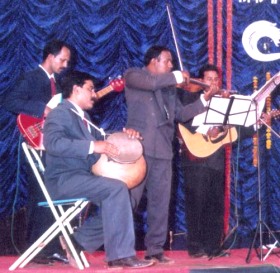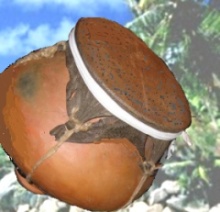Goan mandos: Indo-Portuguese fusion music
 Since the last few decades, fusion music has been making waves all across the world as an exciting new style of music. But it all began from the time Pandit Ravi Shankar strummed his sitar at Woodstock, a western music festival, in 1969, at which the likes of Jimi Hendrix and Joan Baez also performed. (On an aside, far from being proud of having taken Indian classical music to the West in a big way at that time, Ravi Shankar lived to regret ever having performed at Woodstock for the audience was largely lakhs of stoned hippies, many of them engrossed in making out at the open-air venue.)
Since the last few decades, fusion music has been making waves all across the world as an exciting new style of music. But it all began from the time Pandit Ravi Shankar strummed his sitar at Woodstock, a western music festival, in 1969, at which the likes of Jimi Hendrix and Joan Baez also performed. (On an aside, far from being proud of having taken Indian classical music to the West in a big way at that time, Ravi Shankar lived to regret ever having performed at Woodstock for the audience was largely lakhs of stoned hippies, many of them engrossed in making out at the open-air venue.)
Later on, musical performances like these came to be more appropriately called world music, for each musical style retained its own individuality. There was no blending of diverse musical genres.
The term fusion music, however, implies an integration of two musical forms to produce a new one and can be more aptly applied to the music of say the late R. D. Burman or now A. R. Rahman, or even Kailash Kher famous for his sufi-rock music.
But if you think Indo-Western music is a modern-day creation, you couldn’t be more wrong. Much before these greats, and others like Colonial Cousins or Apache Indian started belting out their fusion numbers, composers in Goa along the banks of the Zuari in Loutolim, in the villages of Curtorim and Raia in a valley nearby, and in the coastal village of Benaulim were already creating a new form of music by integrating Goan (Indian) and Lusitanian (Western) musical traditions.
Drawing on their native musical sensibilities and on the nuances of western music they had imbibed from the Portuguese, our creative geniuses produced a form of music that is in a class apart and is one of the finest examples of what a bicultural heritage can produce in the world of music.
So now you know. We Goans had beat everybody else to it when we created an early form of fusion music – the Goan mando – more than 150 years ago!
The Goan mando composers and their amazing creations
The mando took root in the soil of Salcete. An exquisitely divine creation of Saxtti Catholic musicians, it then spread to the rest of the Catholic community in Goa. Jose Periera, the veteran Goan scholar who once taught theology at Fordham University, New York, put it really beautifully at the launch of his outstanding book “Song of Goa” a couple of years ago. He said, the mandos created by the early Saxtti composers were, in a way, an attempt to create a small Vienna in their villages along the banks of the Zuari surrounded by the forests of Salcete.
The theme of mandos was mainly expressions of love, i.e. yearning (utrike), union (ekvott), or lament (villap). Therefore, most of them were a poignant representation of the intensity and pain of love between a man and a woman.
According to Pereira, a blending of two ideologies is evident in mando compositions: Christianity and Romanticism.
Very true, for on one hand, our Goan mandos reflect the traditionality and rigidity of orthodox Christianity that espoused only marital love as in Tambde rozad tuje pole (Your cheeks are as red as roses), and on the other, the spontaneity of Romanticism, an ideology that flourished in the 18th century and denounced the restrictions imposed by rules as in Gupit mog burgeaponnancho (Secret / forbidden love in the days of our youth).
The Goan mando composers and lyricists were many, but those with the maximum creations to their name include Paulo Milagres Silva from Loutolim (1855-1931), Arnaldo de Menezes from Curtorim (1863-1917), Gizelino Rebelo from Verna (1875-1931) and Torquato de Figueiredo from Loutolim (1876-1948).
Most of the composers were poets too and wrote the lyrics for their own compositions. Also, in the early days, most of these gifted composers were Goan Catholic Brahmins. In later years there were a few exceptions, one of them being Antonio Joao Dias of Benaulim who was the son of a carpenter and composed the mando ‘Sangato Moga Tuzo’ (Your friendship, my beloved) around 1914.
The names of the composers of some of our popular mandos like Dorieachea Larari (By the waves of the sea) have been lost in the annals of time. But we do know who the composers of many others were. For instance, here’s what I found by researching this subject:
Torquato de Figueiredo: Adeus korcho vellu paulo (It’s time to say goodbye)
Arnaldo de Menezes: Sontos bogta re jivaco (I feel the joy of life)
Sebastiao (Champion) Alvares (1915-1991): Thoddoch temp ami bonvleanv mogan/ Estimasanv Rozachem, (We were in love for a short while / My love for Roza)
Ligorio Costa (1851-1919) from Curtorim: Tamde rozad tuje pole
Caetano Coutinho (1918 -1964) from Divar, Ilhas: Surya moga podlo / Surya kupant dhamplo (The sun has set, my love / The sun is hidden by the clouds)
Luis Manuel Menezes (1866-1936) from Divar, Ilhas: Sounsar chearuch re dissancho (This world is just of four days – meaning “Life is short”)
R.L. Dalgado: Ugddas Eta Natalanch’ Ratricho (I remember that Christmas night)
Musical instruments
 Portuguese-introduced instruments like the rebec (violin), piano, and mandolin, and nowadays even the box guitar, are often used as accompaniments for Goan music including the mando. But it is the beats of the Goan ghumot, a traditional percussion instrument, that provide the rhythm for any mando and adds to it that local flavor and vitality.
Portuguese-introduced instruments like the rebec (violin), piano, and mandolin, and nowadays even the box guitar, are often used as accompaniments for Goan music including the mando. But it is the beats of the Goan ghumot, a traditional percussion instrument, that provide the rhythm for any mando and adds to it that local flavor and vitality.
The ghumot is actually a mud pot ingeniously transformed into a musical instrument. It has a wide opening at one end traditionally covered with the tightly stretched skin of the monitor lizard, and a narrower one that is uncovered.
In the next post, we’ll move on to the fascinating lyrics of popular mandos and explore the actual incidents that inspired them.

Very informative and much appreciated. Enjoyed the article immensely.
Thank You.
So glad you both liked it. And thanks for the appreciation.
So cool. Enjoyed reading this.
Glad you liked the post. Do share the link with mando lovers you know (of which there are thousands across the globe, I’m sure).
Spot on with this write-up; I seriously believe this site needs far more attention.
I’ll probably be returning to read more, thanks for the information!
Feel free to surf my web blog; unknown
Thanks for that great compliment Susannah. I’m one of those technologically challenged persons and not a fan of play stations, so I’m afraid though I did check out your website much of the stuff about the play station went over my head! All the best with the blogging!